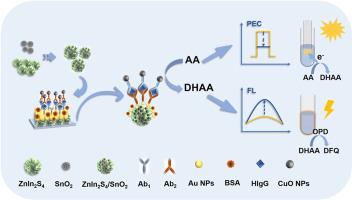通过 ZnIn2S4/SnO2 基系统中的氧化铜纳米酶催化荧光物种生成和光电化学变化实现人免疫球蛋白的双模式检测
IF 5.7
2区 化学
Q1 CHEMISTRY, ANALYTICAL
引用次数: 0
摘要
人类免疫球蛋白(HIgG)已被公认为诊断和治疗各种疾病的重要生物标志物,尤其是在确定麻疹和肺炎球菌疾病等疾病的血清水平升高方面。然而,传统的检测方法往往因效率低下、成本高昂和潜在的不准确性而受到阻碍,因此迫切需要更灵敏、高效、准确和自我校准的 HIgG 检测方法。本文合成了一种新型 ZnIn2S4/SnO2 复合材料,其特点是在花状 ZnIn2S4 结构上均匀分散了 SnO2 纳米颗粒,从而形成了一种 II 型异质结,促进了光生载流子的分离和转移。在优化条件下,这种复合材料的光电流显著增强,分别是单个 ZnIn2S4 或 SnO2 的 52 倍和 195 倍。随后,研究人员利用 ZnIn2S4/SnO2 作为光电化学(PEC)信号发生器和抗体载体,开发出一种新型双模式生物传感器。该系统利用具有抗坏血酸氧化酶类似特性的多功能 CuO NPs 作为第二抗体标签。与 HIgG 特异性结合后,由于 CuO NPs 的催化活性和抗原-抗体的相互作用,PEC 反应会明显降低。邻苯二胺(OPD)的引入促进了荧光物质 DHAA 的形成,从而进一步增强了检测能力。这种双信号方法在 PEC 信号和荧光信号与 HIgG 浓度之间产生了极好的线性关系,实现了 22.5 pg/mL 或 8.6 pg/mL 的低检测限。这两个信号来自同一个 PEC 电极,在没有 OPD 和有 OPD 的情况下均可连续检测,从而简化了实验程序,提高了检测的可靠性。无毒、化学性质稳定的 ZnIn2S4/SnO2 复合材料在与生物分子孵育后通过光电流输出确保了可靠、灵敏的检测。纳米酶催化、生物特异性反应和原位荧光产物生成的整合保证了各种免疫传感应用的高选择性。本文章由计算机程序翻译,如有差异,请以英文原文为准。


Dual-mode detection of human immunoglobulin via copper oxide nanozyme catalysis fluorescent species generation and photoelectrochemical alteration in ZnIn2S4/SnO2-based system
Human immunoglobulin (HIgG) has gained recognition as a crucial biomarker diagnosing and treating various diseases, particularly in identifying elevated serum levels in conditions like measles and pneumococcal disease. Traditional detection methods, however, are often hindered by inefficiencies, high costs, and potential inaccuracies, underscoring the urgent need for more sensitive, efficient, accurate, and self-calibration methods for HIgG. Here, a novel ZnIn2S4/SnO2 composites was synthesized, featuring uniformly dispersed SnO2 nanoparticles on the flower-like ZnIn2S4 structure, resulting in a type II heterojunction that promotes the separation and transfer of photogenerated carriers. Under optimized conditions, this composite demonstrated remarkable photocurrent enhancements 52 and 195 times greater than that of the individual ZnIn2S4 or SnO2, respectively. A novel dual-mode biosensing platform was subsequently developed, employing the ZnIn2S4/SnO2 composites as both as the photoelectrochemical (PEC) signal generator and antibody carrier. This system utilizes multifunctional CuO NPs with ascorbic acid oxidase-like properties, serving as a secondary antibody label. Upon specific binding to HIgG, a notable decrease in the PEC response occurs due to the catalytic activity of CuO NPs and the antigen-antibody interactions. The introduction of o-phenylenediamine (OPD) further enhances detection by facilitating the formation of a fluorescent substance DHAA. This dual-signal approach yielded excellent linear correlations between both PEC and fluorescence signals and HIgG concentration, achieving low detection limits of 22.5 pg/mL or 8.6 pg/mL. These two signals originated from the same PEC electrode with continuous detection in the absence and presence of OPD, simplifying experimental procedures and enhancing the reliability of detection. The non-toxic, chemically stable ZnIn2S4/SnO2 composites ensures reliable and sensitive detection through photocurrent output after incubation with biomolecules. The integration of nanozyme catalysis, biospecific reactions, and in situ fluorescent products generation promise high selectivity across diverse immunosensing applications.
求助全文
通过发布文献求助,成功后即可免费获取论文全文。
去求助
来源期刊

Analytica Chimica Acta
化学-分析化学
CiteScore
10.40
自引率
6.50%
发文量
1081
审稿时长
38 days
期刊介绍:
Analytica Chimica Acta has an open access mirror journal Analytica Chimica Acta: X, sharing the same aims and scope, editorial team, submission system and rigorous peer review.
Analytica Chimica Acta provides a forum for the rapid publication of original research, and critical, comprehensive reviews dealing with all aspects of fundamental and applied modern analytical chemistry. The journal welcomes the submission of research papers which report studies concerning the development of new and significant analytical methodologies. In determining the suitability of submitted articles for publication, particular scrutiny will be placed on the degree of novelty and impact of the research and the extent to which it adds to the existing body of knowledge in analytical chemistry.
 求助内容:
求助内容: 应助结果提醒方式:
应助结果提醒方式:


